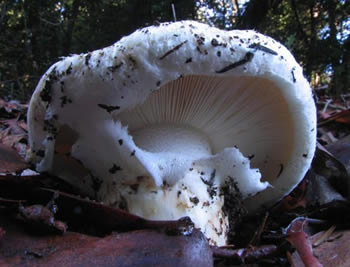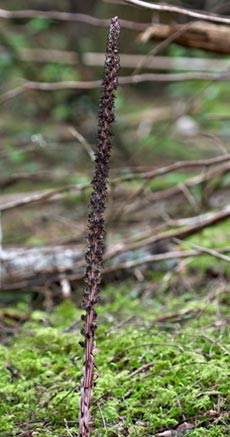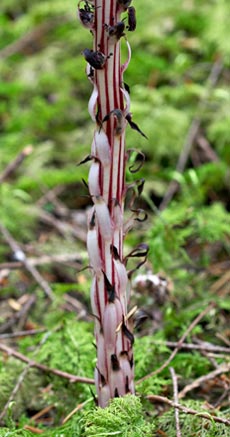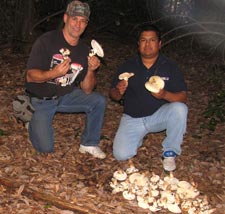Tricholoma murillianum
The Marvelous Matsutake
One of our most beautiful and distinctively delicious local winter mushrooms is the pure white matsutake. Like an amanita, it has white gills and a fluffy white universal veil which covers the entire mushroom in youth. Unlike an amanita, it also has an amazingly distinctive fragrance, which David Arora, author of Mushrooms Demystified, describes as a cross between cinnamon red hots and dirty socks. Can’t wait to dig in, can you? Indeed, eating matsies (the affectionate nickname for the species) can be an acquired taste.

© photo by Hugh Smith
The fragrance of a matsutake is not only catnip to discerning gourmets. Deer and squirrels also find them delicious, and matsies can sometimes be located because another four-footed forager has already pulled one up and left it partially nibbled and exposed upon the ground, or on a log. These blazing white beacons of delectability cue you in to look a little harder for mushrooms that may be hidden in the duff.
In the Pacific Northwest Tricholoma murillianum (formerly T. magnivelare) is found primarily with pine, and in fact, one of the mushrooms nicknames is the “pine mushroom.” They grow in sandy soil and are mycorrhizal with a variety of conifers. When the mushrooms are still buttons below the surface, they form subtle bumps in the duff, barely noticeable to the untrained eye; matsutake at this stage are best located through careful patting of the ground. In Northern California, matsutakes are commonly associated with Tan Oak (Lithocarpus densiflorus), and to a lesser extent Golden Chinquapin (Chrysolepsis chrysophylla), Madrone (Arbutus menziesii) and Manzanita (Arctostaphylus sp.).
John Getz, master matsutake hunter from southern Oregon, was the first to notice the relationship between matsutake and the parasitic plant, Allotropa virgata, or the “Candy cane.”


Allotropa virgata, the "Candy Cane." © Daniel Mosquin
Finding a Candy cane in the field is a sure indication of matsutake mycelia. Allotropa is an obligate parasite upon matsutake. If you dig directly under an Allotropa, whether it is freshly striped red and white, or brown and withered, you will find matsutake mycelia. This mycelia is white or with a bluish tint, and has the same distinctive smell as the mushroom itself. Matsutake never fruit directly within a standing Allotropa patch. They are usually found within 5–15 feet away.
In Japan, the national passion for matsutake takes on a ritual aspect, with a single, perfect mushroom selling for over a hundred dollars. High prices are commanded not only because of centuries of reverence and tradition, but because of the limited local resource. With demand greater than supply, the Japanese have had to seek elsewhere for this unique cultural and culinary delight. Tons of matsutake have been exported to Japan from the Pacific Northwest. Ironically, much of this harvest by locals has been by out of work loggers, whose post-collapse-of-the-logging-industry income is now dependant upon standing trees. Although these Pacific Northwest mushrooms formerly commanded relatively high prices, competition, coupled with lower prices from matsutake hunters in the Mexican mountains and elsewhere, has taken a big bite out of the market.

A succesful matsutake hunt. © Hugh Smith
With age, the fluffy white matsutake veil collapses against the body of the mushroom, and will often stain brown. Unopened buttons are the most prized, as they have the best longevity for shipping, and stay the cleanest. Opened buttons and mature matsutakes are also delicious, but the gills can often be coated with sand and difficult to clean, making for a crunchy and most unpalatable meal. When in the button stage, the mushroom flesh is so hard that it can literally squeak when you cut it.
Experienced matsutake hunters know how to read sign and locate and extract their quarry without damaging the surrounding habitat or mushroom mycelia; raking for matsutake is strictly taboo. Raked duff is a tell-tale sign of your patch, and is frowned upon by all ethical hunters. Most matsutake hunters have a deep bond to the forests that provide both their sustenance and livelihood, and it is a point of pride to develop your eye and technique so as to be both successful in the hunt, and leave no trace of your passing.
The fruiting of matsutake is strongly correlated to low temperatures, and a pattern of warming and cooling. It is less strongly linked to rainfall patterns.
For more fascinating information on the matsutake and its complex web of hosts and hunters, visit www.matsiman.com.
© Debbie Viess

 back to top
back to top